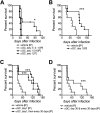Alpha-galactosylceramide as a therapeutic agent for pulmonary Mycobacterium tuberculosis infection
- PMID: 20508216
- PMCID: PMC2949408
- DOI: 10.1164/rccm.200912-1921OC
Alpha-galactosylceramide as a therapeutic agent for pulmonary Mycobacterium tuberculosis infection
Abstract
Rationale: Invariant natural killer T (iNKT) cells are a unique subset of T cells that recognize lipid antigens presented by CD1d molecules. Recent studies have shown that iNKT cells can protect mice against Mycobacterium tuberculosis (Mtb) infection. We sought to determine whether pharmacological activation of iNKT cells by α-galactosylceramide (α-GalCer) could be used to treat tuberculosis (TB).
Objectives: We hypothesized that α-GalCer, either alone or in combination with isoniazid, could be used to treat pulmonary TB.
Methods: The ability of α-GalCer-activated iNKT cells to suppress Mtb replication was evaluated using an in vitro coculture system. To test its potency in vivo, mice infected with virulent Mtb were treated with α-GalCer alone or in combination with isoniazid.
Measurements and main results: Quantitative colony-forming unit counts were compared for both experimental systems. Our results show that α-GalCer plus isoniazid controls bacterial growth better than α-GalCer or INH alone, and single or multiple α-GalCer administrations prolong the survival of the mice infected via the aerosol route.
Conclusions: Our results demonstrate that α-GalCer administration can improve the outcome of Mtb infection, even when transmitted by the aerosol route. However, a combination of isoniazid and α-GalCer treatment has a synergistic effect on infection control. We conclude that more efficient treatment of TB will be achieved through a combination of classic chemotherapy and modulation of the host immune response.
Figures




Similar articles
-
Innate invariant NKT cells recognize Mycobacterium tuberculosis-infected macrophages, produce interferon-gamma, and kill intracellular bacteria.PLoS Pathog. 2008 Dec;4(12):e1000239. doi: 10.1371/journal.ppat.1000239. Epub 2008 Dec 12. PLoS Pathog. 2008. PMID: 19079582 Free PMC article.
-
Quantitative and qualitative iNKT repertoire associations with disease susceptibility and outcome in macaque tuberculosis infection.Tuberculosis (Edinb). 2017 Jul;105:86-95. doi: 10.1016/j.tube.2017.04.011. Epub 2017 Apr 28. Tuberculosis (Edinb). 2017. PMID: 28610792 Free PMC article.
-
Imaging α-GalCer-Activated iNKT Cells in a Hepatic Metastatic Environment.Cancer Immunol Res. 2022 Jan;10(1):12-25. doi: 10.1158/2326-6066.CIR-21-0445. Epub 2021 Nov 16. Cancer Immunol Res. 2022. PMID: 34785505
-
Tailored design of NKT-stimulatory glycolipids for polarization of immune responses.J Biomed Sci. 2017 Mar 23;24(1):22. doi: 10.1186/s12929-017-0325-0. J Biomed Sci. 2017. PMID: 28335781 Free PMC article. Review.
-
α-GalCer and iNKT Cell-Based Cancer Immunotherapy: Realizing the Therapeutic Potentials.Front Immunol. 2019 Jun 6;10:1126. doi: 10.3389/fimmu.2019.01126. eCollection 2019. Front Immunol. 2019. PMID: 31244823 Free PMC article. Review.
Cited by
-
The immune response and antibacterial therapy.Med Microbiol Immunol. 2015 Apr;204(2):151-9. doi: 10.1007/s00430-014-0355-0. Epub 2014 Sep 5. Med Microbiol Immunol. 2015. PMID: 25189424 Review.
-
T Cells Specific for a Mycobacterial Glycolipid Expand after Intravenous Bacillus Calmette-Guérin Vaccination.J Immunol. 2021 Mar 15;206(6):1240-1250. doi: 10.4049/jimmunol.2001065. Epub 2021 Feb 3. J Immunol. 2021. PMID: 33536255 Free PMC article.
-
Invariant Natural Killer T Cells as Key Players in Host Resistance against Paracoccidioides brasiliensis.J Immunol Res. 2021 Apr 16;2021:6673722. doi: 10.1155/2021/6673722. eCollection 2021. J Immunol Res. 2021. PMID: 33954206 Free PMC article.
-
NK1.1+ cells and IL-22 regulate vaccine-induced protective immunity against challenge with Mycobacterium tuberculosis.J Immunol. 2012 Jul 15;189(2):897-905. doi: 10.4049/jimmunol.1102833. Epub 2012 Jun 18. J Immunol. 2012. PMID: 22711885 Free PMC article.
-
Sex differences in tuberculosis.Semin Immunopathol. 2019 Mar;41(2):225-237. doi: 10.1007/s00281-018-0725-6. Epub 2018 Oct 25. Semin Immunopathol. 2019. PMID: 30361803 Review.
References
-
- Federal Tuberculosis Task Force. Plan to combat extensively drug-resistant tuberculosis: recommendations of the Federal Tuberculosis Task Force. MMWR Recomm Rep 2009;58:1–43. - PubMed
-
- Blumberg HM, Burman WJ, Chaisson RE, Daley CL, Etkind SC, Friedman LN, Fujiwara P, Grzemska M, Hopewell PC, Iseman MD, et al. American Thoracic Society/Centers for Disease Control and Prevention/Infectious Diseases Society of America: treatment of tuberculosis. Am J Respir Crit Care Med 2003;167:603–662. - PubMed
-
- Bendelac, A., Savage PB, Teyton L. The biology of NKT cells. Annu Rev Immunol 2007;25:297–336. - PubMed
-
- Wu L, Gabriel CL, Parekh VV, Van KL. Invariant natural killer T cells: innate-like T cells with potent immunomodulatory activities. Tissue Antigens 2009;73:535–545. - PubMed
Publication types
MeSH terms
Substances
Grants and funding
LinkOut - more resources
Full Text Sources
Other Literature Sources

